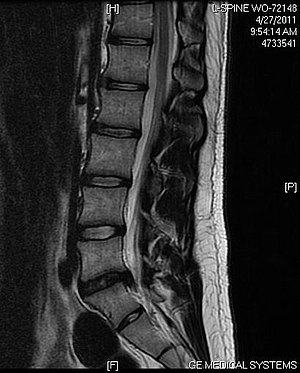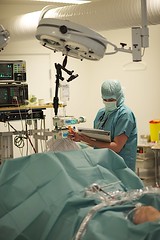By Dt. Steven Warfield
Many people have at one time
or another experienced the onset of debilitating back pain. It could be the result of anything from
trying to lift a heavy object to playing with their children. All of a sudden there is a searing pain and
then the body no longer functions as it should.
Trying to stand up or in some cases even walk is all but impossible. A trip to the doctor’s office for x-rays and
then an MRI reveals a herniated disk. In
the past this prognosis most often meant surgical intervention and a long
recovery. But modern advances in medical
technology have produced an alternative to going under the knife for many
people.
VAX-D
to the Rescue
Called vertical axial
decompression therapy, VAX-D treatment begins by having the patient lie face
down on a computer controlled table. The
patient, who has donned a pelvic harness, grasps two handgrips. To begin treatment, the table separates
slightly stretching the patients ba
 |
| English: Example of a herniated disc at the L5-S1. (Photo credit: Wikipedia) |
ck. Therapy consists of alternately
stretching and relaxing the spine in order to relieve pressure. The handgrips
allow the patient to halt treatment at any time by merely releasing the
handgrips. .
Developed by Dr. Allen E.
Dyer MD, VAX-D was developed specifically to treat herniated or degenerated
disks by lowering spinal pressure to create a partial vacuum that can then
retract the disk. Many times even a
large protruding disk can be retracted to where it is supposed to be using this
treatment.
How
Effective is VAX-D?
The inventor
of VAX-D, Dr. Dyer, recommends that patients only engage in nothing more
strenuous than walking during the month following treatment. He also states that, “If patients receive this treatment five days
a week, for a month, 70% of them will be free of pain. What do they do when
it's done? They go skiing. Dumb!" he says. “When the pain is gone, that
doesn't mean the fracture is completely healed. Exercise does nothing for an
intradisk lesion or a herniated disk. What it does is put stress on a disk
that's trying to heal."
What Makes
VAX-D Different?
Mechanical traction has been used for decades to treat
herniated disks. Conventional traction
uses two harnesses, one for your chest and the other for your pelvis. Using a percentage o
 |
| Stages of Spinal Disc Herniation (Photo credit: Wikipedia) |
f your body weight to
pull the bones apart, some treatments use a static pressure while others rely
on intermittent pressure. The problem
with traditional traction is that the chest harness is uncomfortable. Add to this the fact that traditional
traction can cause the muscles to tighten in an attempt to resist the
stretch. VAX-D eliminates the chest
harness and produces results by creating negative intradiscal pressure that
creates a vacuum unattainable by traditional traction or inversion tables. VAX-D also differs from traditional traction
in that the patient lies face down, which helps coax the discs back into place,
since disc protrusions are most commonly posterior. It also utilizes intermittent periods of
traction with gradual increases of force.
Typical treatments last anywhere from 20-45
minutes. The recommended regimen for
treatment is 24 sessions over the treatment period, followed by a maintenance
program.
Is VAX-D the solution for you? Ask your chiropractic physician. But for those who suffer from chronic back
pain, this is one non-surgical option where the only thing you have to lose is
pain.
Dr.’s
Steven Warfield and Dave
Edenfield offer the most advanced treatments for back
pain, sciatica, neck pain, whiplash and headaches. They also treat auto
accident victims with state-of-the-art technologies. If you or
anyone you know suffers from herniated discs, degenerative discs or spinal stenosis,
visit http://www.lakewoodchiropracticjax.com/&
http://chiropractor-jacksonville-fl.com
Related articles



























